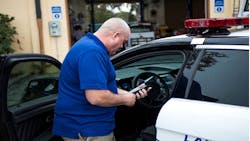Too Much Equipment, Not Enough Trunk Space
By Thomas Kanewske - Business Development Manager, Derive Systems
Let’s face the elephant in the room – law enforcement duties are growing and the space in your vehicles is getting smaller. The facts are simple: more missions equal more gear and the gear realistically has but one place it can go – your vehicle.
So why are these effects so pronounced now? It’s simply that today’s mission duties span the likes of riot response, disaster relief, counter-drug or counter-terrorism, and emergency medical response situations that range from life threatening car accidents all the way to mass casualty response. The problem, however, is that none of this equipment can be brought to bear when you don’t have somewhere convenient and readily accessible to store it all.
Here-in lies the challenge; gone are the days of the cavernous Crown Vic with its almost 21 cubic feet of trunk volume; instead, today’s police cars are anywhere from roughly 15% to 20% smaller. This limiting factor has had several first order effects: either fleets have upsized and purchased more expensive SUVs, or they have cut back on carrying now-needed gear. But that’s not all, there’s also been one lesser known side-effect – a move away from alternate fuel conversions to improve on fuel efficiency.
As many of you are aware, alternate fuel conversion kits for law enforcement vehicles historically found a home in the trunk. But with only 16-odd cubic feet to start with in new vehicles, this conversion can quickly strip away what little space there already was, leaving the officer with a storage crisis. And while some may view the only answer as “paying up” for the larger SUV, optimized engine calibrations can offer a much more pragmatic solution with three considerable benefits: preservation of trunk space through no added hardware/weight, improved fuel efficiency, and reduced environmental impact.
Now that all the latest models of cars are equipped with advanced computers to help run their internal systems and engines, it’s easy to access those computers in order to optimize engine operations for your specific mission. These calibrations not only preserve the officers’ trunk space that would have been taken up by CNG and propane tanks, but they also offer similar or better fuel savings. For example, Derive Systems’ proprietary software can make focused-changes to a law enforcement vehicles’ generic OEM calibration and deliver an 8% to 12% fuel savings. Derive’s technology can enable those vehicles to idle at a lower RPM, meaning less fuel consumption, lower costs, and a smaller carbon footprint. Ultimately, this leads to immense savings and utility for police fleets.
One of Derive’s customers, the Police Department of Port St. Lucie, Florida, is proof that these technology solutions can be incredibly effective and useful for law enforcement fleets. Their department saw a 12% reduction in idle fuel consumption, an 11% decrease in total spending on fuel, and a carbon footprint reduction of 200 pounds per vehicle per month.
So whether your department is considering the new police-equipped SUVs or sedans to enhance your fleet, don’t forget to consider how solutions such as Derive’s can help resolve potential storage or fuel-consumption issues with your vehicles.
